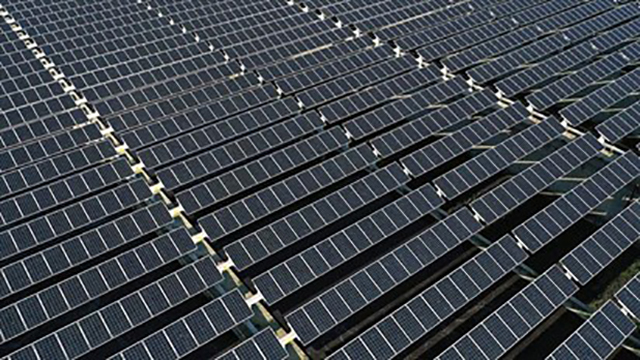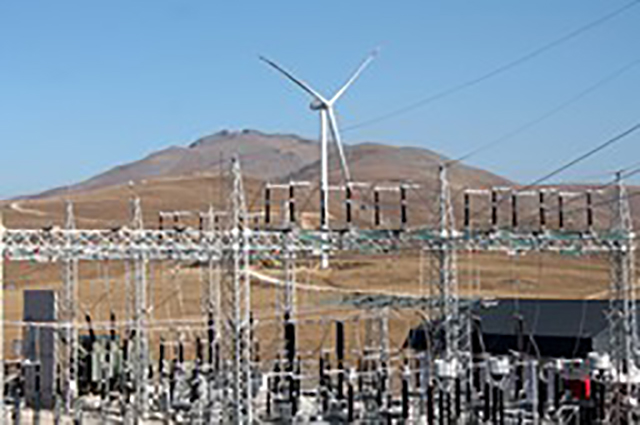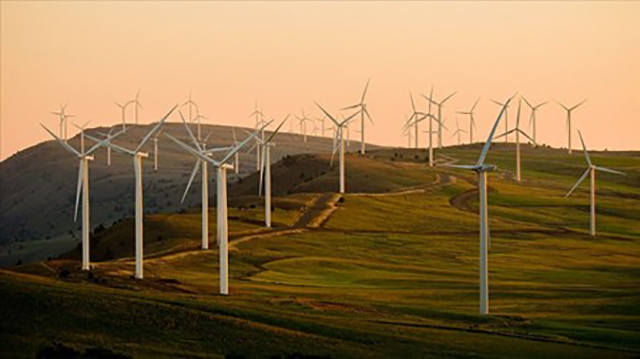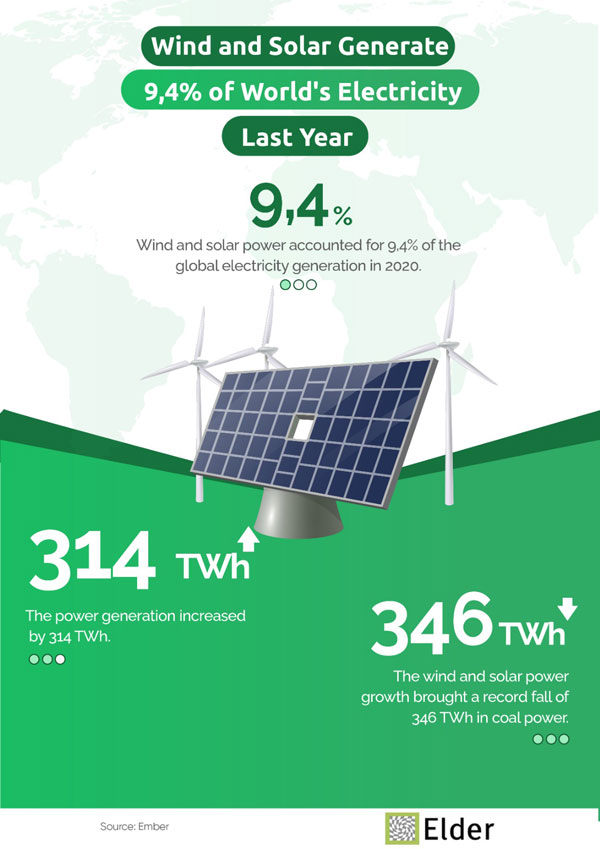
World’s wind and solar share of production doubles since 2015 by comparison while Turkey's triples
Turkey outpaced the world average in electricity generation from wind and solar in 2020, according to data compiled by Anadolu Agency from the Global Electricity Review 2021 report of London-based think-tank, Ember on Monday.
Turkey generated 12% of its electricity from wind and solar in 2020 relative to the world average of 9.4%. Turkey's total electricity generation stood at 302 terawatt-hours (TWh) last year with demand at 301.5 TWh, marking a 0.6% increase compared to 2019.
The share of all renewable sources stood at 43% of the country’s power generation, with coal and gas accounting for 34% and 23%, respectively. The share of clean energy sources out of global electricity generation last year, including nuclear, was 39%, while coal was 34%.
Turkey was placed above the global average with wind and solar comprising 12% of its electricity last year, and the country ranked fifth out of G20 countries for the share of wind and solar production, ahead of the US and France. Wind and solar electricity generation in Turkey increased by 15%, or 5 TWh in 2020 and installed capacity grew by 2 gigawatts (GW) to reach just under 16 GW.
Wind, in particular, showed strong growth with 1.2 GW of additional installed capacity in 2020, doubling the amount installed in 2019 and reaching a total of 9 GW. However, the amount of additional solar capacity installed in 2020 was down 28% compared to 2019.
Turkey needs to maintain the growth in wind generation and escalate investment in solar power to increase the share of clean power, the report revealed. Hydro production fell 12%, or 11 TWh year-on-year due to lower rainfall and because 2019 was a record year for renewables, with hydroelectricity generation up by 10%.
The report said that generation last year at the three largest hydroelectric plants, Ataturk, Karakaya and Keban, was twice that seen in 2019 compared to 2018 due to above-average seasonal rainfall and snowfall. The drought in Turkey that followed in the second half of 2020 allowed a recovery in fossil gas generation with a 25% increase, or 13 TWh year-on-year, representing the highest annual fossil gas gain among G20 countries.
Last year, total electricity generation from coal dropped by 6%. This was mostly because five lignite plants had to cease operations in early 2020, as they did not make the necessary upgrades to comply with environmental regulations. This brought a drop of 18% in lignite-fired electricity generation. In Turkey, 1.6 GW of additional capacity was under construction in 2020 while 12.4 GW of proposed capacity was canceled, according to the report.
The world’s wind and solar share of production have doubled from 2015 to 2020 by comparison while Turkey’s has "impressively" tripled, according to the report. Turkey's overall renewable power generation has overtaken coal four-fold since 2015, however, the last two years showed the highest margin at 9%.
Before 2015, renewables output was never higher than fossil fuels combined but in 2019 and 2020 the gap between them substantially dropped. While renewable sources accounted for 33% of electricity generation in 2015, in 2020 they reached 43%, showing a greater uptake than the world average. Wind and solar increased their share of total generation from around 4% in 2015 to 12% in 2020 with a growth of 23 TWh.
In line with the global trend, renewable electricity, particularly hydro, displaced fossil gas rather than coal. Electricity generation from natural gas plants fell by around 15% since 2015 but recovered in 2020 as hydro generation returned to normal levels of 26% due to the drought. The share of natural gas in power generation was 37% in 2015 but fell to about 23% in 2020.
The dominance of gas over renewables is not expected to return to 2015 levels if wind and solar continue their steady growth, Ember said. Although Turkey's coal generation showed a decrease of 6% last year, it has grown by 39%, or 28 TWh overall, since 2015. Turkey is one of the three G20 countries where coal's share of production has increased during this period, the others being Indonesia and Russia.
Coal accounted for 29% of electricity generation in 2015 but this rose to 34% in 2020, with an increase of 4 GW in installed capacity over this period. Turkey's electricity demand, which is 1.5 times the global average per capita, grew steadily by 15% since 2015. According to the report, Turkey has the largest pre-construction pipeline in Europe for new coal-fired plants and ranks third globally behind China and India. This equates to 18 GW and 23 plants, but it is highly unlikely that the majority of these plants will be commissioned as around 80 coal projects have been canceled in Turkey over the last decade.
Source: Anadolu Agency

Turkey’s energy import bill dropped by 12.2% year-on-year in February this year, according to data released by the Turkish Statistical Institute (TurkStat) on Wednesday.
The overall energy import bill fell to $2.75 billion (TL 22.91 billion) last month as the country boosted its domestic and renewable energy production. The data showed that Turkey’s overall import bill, including energy and other items, totaled $19.3 billion in February, with energy accounting for 14.25% of the overall figure.
Exports increased by 9.6% on an annual basis to reach $16 billion, the statistical body said. The figures resulted in an 8.7% increase in the foreign trade deficit in the month. The gap came in at nearly $3.3 billion, according to the data.
“Foreign trade deficit, excluding energy products and non-monetary gold, was $224 million in February 2021,” the institute noted. The country’s crude oil imports showed a 32.6% decrease compared to February 2020. Turkey imported approximately 1.57 million tons of crude oil last month, down from 2.33 million tons in February 2020. The overall export-import coverage ratio was 82.9% in February, up from 82.8% in the previous year.
In the month, the manufacturing industries products took the lion’s share from overall exports with 94.2%, followed by agriculture-forestry-fishing with 3.6% and mining-quarrying with 1.8%. While Germany was the main destination of Turkish exports with a share of 9.4%, China was the main source of imports with a share of 11.6%. Foreign trade statistics are calculated using two different methods: the special and the general trade systems. The general trade system is a wider concept, including customs warehouses, all types of free zones, free circulation areas, and premises for inward processing.
“According to the special trade system, in February 2021, exports were $15.1 billion with an 8.8% increase and imports were $18.58 billion with a 9.1% increase compared with February 2020,” the institute said.
During the first two months of the year, exports surged by 5.9% to reach $31.04 billion and imports were up by 1.4% to reach $37.38 billion. In the January-February period, the trade deficit narrowed by 15.9% to $6.35 billion, versus the same period last year.
Source: Daily Sabah

New energy policies are urgently needed to put countries on the path to net zero greenhouse gas emissions, the world’s leading energy economist has warned, as economies are rapidly gearing up for a return to fossil fuel use instead of forging a green recovery from the Covid-19 pandemic.
Most of the world’s biggest economies now have long-term goals of reaching net zero by mid-century, but few have the policies to meet those goals, said Fatih Birol, the executive director of the International Energy Agency (IEA).
The IEA’s latest figures show global coal use was about 4% higher in the last quarter of 2020 than in the same period in 2019, the clearest indication yet of a potentially disastrous rebound in the use of the dirtiest fossil fuels, following last year’s lockdowns around the world when emissions plummeted.
Birol told the Guardian: “We are not on track for a green recovery, just the opposite. We have seen global emissions higher in December 2020 than in December 2019. As long as countries do not put the right energy policies in place, the economic rebound will see emissions significantly increase in 2021. We will make the job of reaching net zero harder.”
He urged governments to support clean energy and technology such as electric vehicles, and make fossil fuels less economically attractive. “Governments must provide clear signals to investors around the world that investing in dirty energy will mean a greater risk of losing money. This unmistakable signal needs to be given by policymakers to regulators, investors and others,” he said.
The IEA is holding a meeting of governments on Wednesday to sketch out net zero plans. The UK, host of the COP26 UN climate talks later this year, will urge countries that have not yet adopted net zero targets – including India, Indonesia, Mexico, Russia and Saudi Arabia – to take on such commitments, and ask all countries to come up with targets for emissions reductions in the next 10 years that will pave the way to the long-term goal.
Alok Sharma, the UK minister who is president of the Cop26 summit, wrote in the Guardian recently that both long-term net zero targets and short-term 2030 plans would be needed from all countries for the talks to succeed.
Birol said stronger 2030 targets were essential to meet net zero. “Looking at the energy sector, the next 10 years will be very, very critical,” he said. “If governments put money in clean energy finance, in the context of their economic recovery plans, that will make the challenge less difficult.”
He called on the US to lead the way on setting out a national plan, called a nationally determined contribution (NDC), for cutting emissions strongly in the next 10 years. “NDCs should be ambitious, credible, accountable and backed with credible energy policies,” he said. “The US’s current NDC is not ambitious enough, and not in line with the US leading an international climate campaign.”
Source: Guardian

Chinese smartphone maker Xiaomi is joining the electric vehicle gold rush, pledging to pour $10bn into building a smart car over the next decade.
The Beijing-based company said on Tuesday that it would put in Rmb10bn ($1.5bn) to its initial phase of investment, without specifying a time period.
The push makes Xiaomi the latest tech company to join the stampede into electric vehicles, with search giant Baidu earlier this year announcing it would launch a new marque with carmaker Geely, and US tech group Apple reportedly considering a similar move.
Xiaomi did not disclose details such as whether the company would be launching a new brand or outsourcing manufacturing to a third party. According to a Reuters report last week that cited sources, the group would work with private Chinese carmaker Great Wall Motors to build the cars. Xiaomi is one of the world’s largest phonemakers and works with partners to produce a wide range of internet-connected devices, from rice cookers to scooters. But the push into electric cars will be its most ambitious project yet.
“Traditional automakers don’t have the same legacy advantages in making electric cars so it makes sense for highly efficient internet companies who can push software updates to come in and give it a try,” said Yale Zhang, founder of consultancy Automotive Foresight in Shanghai.
Zhang said demand for electric vehicles at the high and low ends of the market was very strong at present. The Hongguang Mini EV, a $4,500 car manufactured by private automaker Wuling in a joint venture with General Motors and state-owned Saic, was China’s best-selling electric vehicle model in February.
Xiaomi enters an increasingly crowded field of automakers, from traditional global brands such as Volkswagen to Chinese start-ups including Nio, Xpeng and Li Auto, all of which are vying to corner China’s strategically important electric car market, the largest in the world. Sales of battery-powered and hybrid vehicles in China hit record highs in December, nearing a tenth of the country’s entire automotive market.
The Chinese government wants a fifth of all sales to be electric by 2025. The potential for rapid growth over the next decade has attracted investors keen to find the Chinese carmaker most likely to take on industry leader Tesla, whose Model 3 was China’s best-selling electric car model in 2020. Demand from young Chinese consumers for technology-laden vehicles, as well as a low barrier for entry owing to traditional automakers such as Geely offering to provide battery and power-train manufacturing systems, has drawn technology groups to the sector.
“Chinese entrepreneurs track what Silicon Valley is doing; there’s envy, so for Xiaomi, which is really a rival to Apple, they see what they’re doing and say, we can be successful at this as well,” said Tu Le, founder of Sino Auto Insights, a consultancy. But Tu noted that while Chinese search giant Baidu brought its AI and autonomous driving capabilities to its electric vehicle project, Xiaomi lacked the same competitive advantage. “They’re going to be pouring billions of billions of dollars into this to enter the most competitive auto market in the world,” he said.
Source: Financial Times

A group of 88 lawmakers in the European Parliament have joined environmental NGOs and the renewable energy industry to demand the exclusion of low-carbon fossil fuels from the upcoming revision of the EU’s Renewable Energy Directive.
The European Commission’s intention to broaden the scope of the directive beyond renewables “is counter-productive and risks promoting the very fossil fuels that renewables should be displacing in Europe’s energy system,” says a letter sent to the European Commission on Wednesday (31 March).
“Non-renewable and low-carbon fuels, including so-called ‘low carbon’ fossil fuels, should not be included in any provision under the Renewable Energy Directive nor should they count towards the EU’s binding 2030 renewable energy target,” the letter states.
Low-carbon fossil fuels include hydrogen made from natural gas steam reforming, coupled with carbon storage technology to bury the emissions underground. The missive was signed by a group of 116 lawmakers, environmental groups, business associations, and energy utilities, including Italy’s Enel and Spain’s Iberdrola.
The initiative is supported by 88 MEPs mostly hailing from the Greens, leftists and Social Democrat (S&D) political factions in the European Parliament as well as the centrist Renew Europe group. Sirpa Pietikäinen, a Finnish MEP, is the only lawmaker from the centre-right European People’s Party (EPP) who signed the letter, highlighting a potential split in the EU assembly on the upcoming revision of the directive. Conservatives and far-right MEPs are not among the signatories.
The move came after European Commissioner for Energy Kadri Simson announced a new certification scheme for renewable and low-carbon fuels and gases as part of the upcoming revision of the Renewable Energy Directive, which is expected in June.
Simson made the comments at the 10th high-level meeting of the EU Refining Forum, a gathering of representatives from the oil refining industry. Oil refiners called for the EU to recognise liquid fuels as a necessary part of achieving decarbonisation, saying that from a chemistry standpoint, “liquid fuels are still simply the best form of energy storage.”
However, the signatories say this would “generate significant public confusion and undermine trust in the EU’s renewable energy policy, which is key to leveraging one of the fastest growing sectors in the economy.”
“The purpose of the Renewable Energy Directive is not to greenwash fossil fuels,” said Philippe Dumas, secretary-general of the European Geothermal Energy Council (EGEC), one of the business associations which signed the missive.
SolarPower Europe, a trade association, were equally dismissive of the idea. “It is important that the scope of the Renewable Energy Directive remains dedicated to renewables so as not to lose momentum in the EU’s ambitious Green Deal targets,” said Walburga Hemetsberger, CEO of SolarPower Europe.
“While the Renewable Energy Directive will be an important vehicle to develop the basis of a sound traceability and certification mechanism for renewable hydrogen, inserting any type of supporting measures for low-carbon hydrogen as part of the Directive would be counterproductive in terms of achieving decarbonisation,” she added.
Source: Euractiv

Researchers from Chalmers University of Technology in Sweden have produced a structural energy storage battery that performs ten times better than all previous versions. It contains carbon fibre that serves simultaneously as an electrode, conductor, and load-bearing material.
Their latest research breakthrough paves the way for essentially ’massless’ energy storage in vehicles and other technology. The batteries in today’s electric vehicles constitute a large part of the vehicles’ weight, without fulfilling any load-bearing function. A structural battery, on the other hand, is one that works as both a power source and as part of the structure – for example, in a car body.
This is termed ‘massless’ energy storage because, in essence, the battery’s weight vanishes when it becomes part of the load-bearing structure. Calculations show that this type of multifunctional battery could greatly reduce the weight of an electric vehicle.
The development of structural batteries at Chalmers has proceeded through many years of research, including previous discoveries involving certain types of carbon fibre. In addition to being stiff and strong, they also have a good ability to store electrical energy chemically. This work was named by Physics World as one of 2018’s ten biggest scientific breakthroughs.
The first attempt to make a structural battery was made as early as 2007, but it has so far proven difficult to manufacture batteries with both good electrical and mechanical properties. But now the development has taken a real step forward, with researchers from Chalmers, in collaboration with KTH Royal Institute of Technology in Stockholm, presenting a structural battery with properties that far exceed anything yet seen, in terms of electrical energy storage, stiffness and strength. Its multifunctional performance is ten times higher than previous structural battery prototypes.
The battery has an energy density of 24Wh/kg, meaning approximately 20% capacity compared to comparable lithium-ion batteries currently available. But since the weight of the vehicles can be greatly reduced, less energy will be required to drive an electric car, for example, and lower energy density also results in increased safety. And with a stiffness of 25GPa, the structural battery can really compete with many other commonly used construction materials.
“Previous attempts to make structural batteries have resulted in cells with either good mechanical properties, or good electrical properties. But here, using carbon fibre, we have succeeded in designing a structural battery with both competitive energy storage capacity and rigidity,” explains Leif Asp, Professor at Chalmers and leader of the project.
The new battery has a negative electrode made of carbon fibre, and a positive electrode made of a lithium iron phosphate-coated aluminium foil. They are separated by a fibreglass fabric, in an electrolyte matrix.
Despite their success in creating a structural battery ten times better than all previous ones, the researchers did not choose the materials to try and break records – rather, they wanted to investigate and understand the effects of material architecture and separator thickness.
Now, a new project, financed by the Swedish National Space Agency, is underway, where the performance of the structural battery will be increased yet further. The aluminium foil will be replaced with carbon fibre as a load-bearing material in the positive electrode, providing both increased stiffness and energy density. The fibreglass separator will be replaced with an ultra-thin variant, which will give a much greater effect – as well as faster charging cycles. The new project is expected to be completed within two years.
Leif Asp, who is leading this project as well, estimates that such a battery could reach an energy density of 75Wh/kg and a stiffness of 75GPa. This would make the battery about as strong as aluminium, but with a comparatively much lower weight. “The next generation structural battery has fantastic potential. If you look at consumer technology, it could be quite possible within a few years to manufacture smartphones, laptops or electric bicycles that weigh half as much as today and are much more compact”, says Leif Asp. And in the longer term, it is absolutely conceivable that electric cars, electric planes and satellites will be designed with and powered by structural batteries.
Source: Smart Energy International
World Energy Transitions Outlook: 1.5°C Pathway
The World Energy Transitions Outlook preview outlines a pathway for the world to achieve the Paris Agreement goals and halt the pace of climate change by transforming the global energy landscape. This preview presents options to limit global temperature rise to 1.5°C and bring CO2 emissions closer to net zero by mid-century, offering high-level insights on technology choices, investment needs and the socio-economic contexts of achieving a sustainable, resilient and inclusive energy future.
Please click here to read the full report.
Eurasia Cogeneration Conference
7 April 2021
IRENEC 2021 11. International 100 Percent Renewable Energy Conference
20 - 22 May 2021
Eurelectric Power Summit 2021
25 - 28 May 2021
Solarex Istanbul
10 - 12 June 2021
You are My Energy Acceleration Program Demo Day Organization
June 2021
8th International Istanbul Smart Grids and Cities Congress and Expo (ICSG 2021)
04 - 05 June 2021
2021 IEEE PES Futuring the Power Grid
14 - 17 September 2021
Solar Istanbul
22 - 25 September 2021
11. Turkey Energy Summit
10 - 12 October 2021
14. EIF World Energy Congress and Expo
13 - 15 October 2021 / Antalya
European Utility Week (Enlit Europe)
30 November - 2 December 2021

